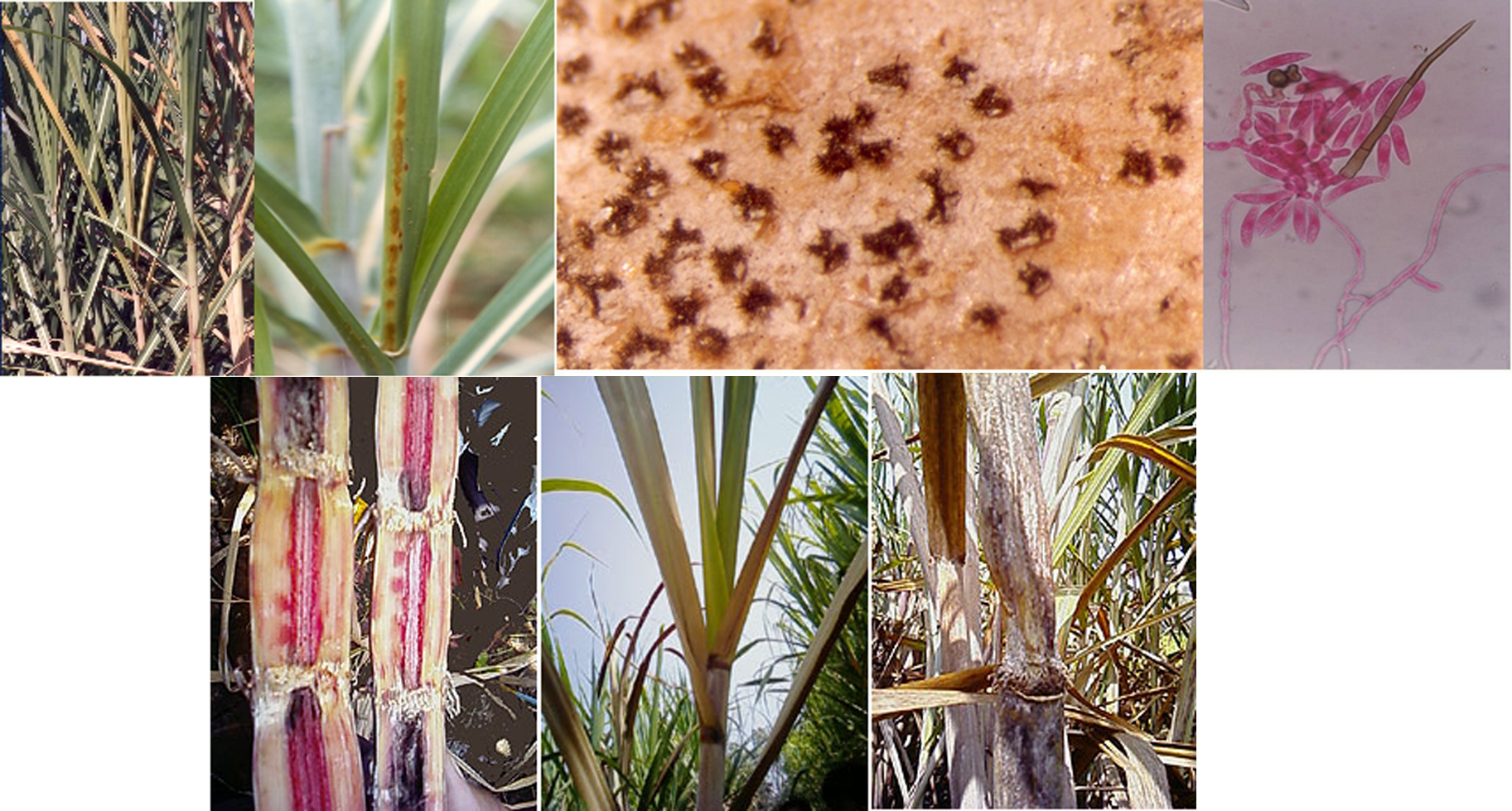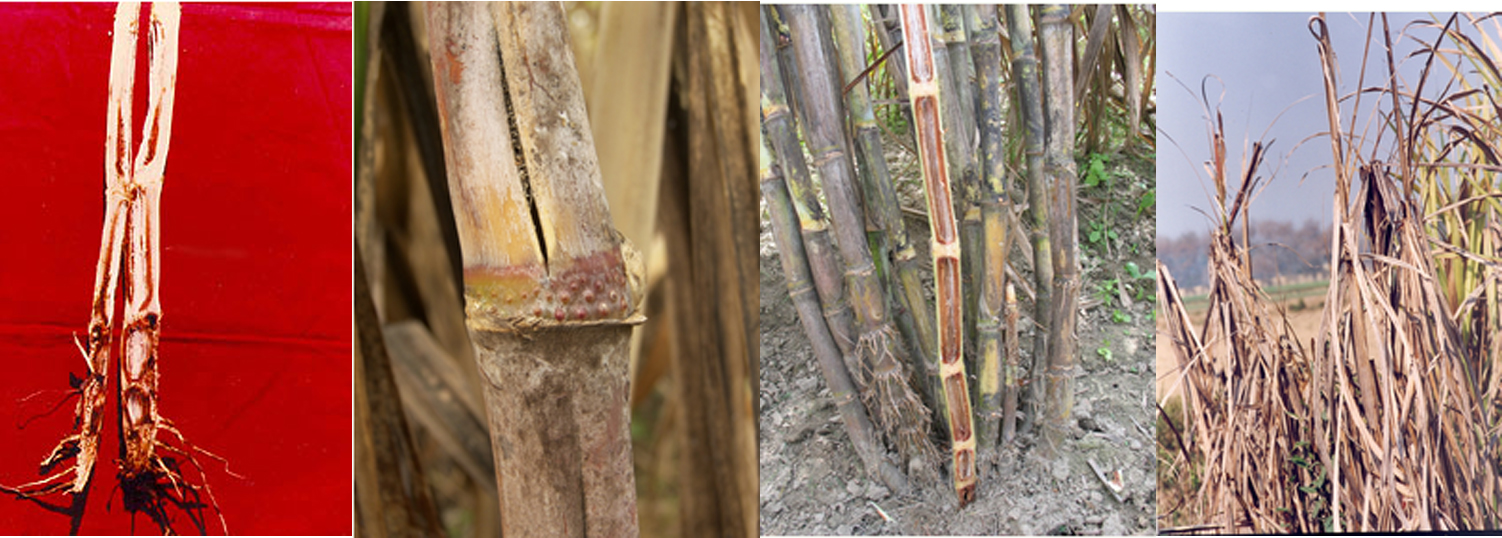Sugarcane Pathology
Sugarcane Pathology section deals with the control of sugarcane diseases like red rot, whip smut, ratoon stunting, Fusarium wilt, and nematodes. Similarly, in sugarbeet Cercospora leaf spot, Sclerotial rot, Phoma betae, Meldiogyne, and cyst nematods are points of focus. Sugarcane Pathologist extends full support to identify and score various diseases on sugarcane clones under test in seedling, non-replicated and replicated trials. Apart from that, production technology is developed with a focus on integrated disease management. A brief account of the major diseases is given in the following sections.
Red rot of sugarcane is caused by a fungus called Colletotrichum falcatum. Some scientists have named as Glomerella tucamanesis Von Arx and Muller (Hafiz, 1986). Primary transmission of the disease is throught soil and disease born setts while secondary transmission is through rain splash and soil. Its symptoms include drying of spindle leaves. Later, the stalks show discoloration and are hollow. Acervuli (black fruiting bodies) can be seen on rind and nodes. A diseased stalk, on splitting gives a sour smell. The internal tissues become red with mixed transverse white spots. With the advancement of the disease, the stalk show an earthy brown color with pith cavity in the center showing hyphae and acervuli. In rainy/humid season red rot spreads so rapidly that all the crop dries out and even a single millable cane is difficult to find.
Control:
- Plant resistant varieties
- Collect healthy seed material
- Treat the setts with a good fungicide by dipping them for 15-20 minutes in the solution.
- For controlling secondary spread of the disease:
- Rogue out the diseased stools and burn them. Don't burry them.
- Soak the spot of the rogued plants with fungicide.
- Spray the crop immediately after seeing the disease symptoms.
- Burn the trash of the diseased crop immediately after harvest.
- Rotating sugarcane with other crop would be good to further devastate the disease spread.
- Do not keep the ratoon of the diseased crop.

Ratoon Stunting Disease (RSD) is a bacterial disease and caused by a xylem limited gram positive bacterium Leifsonia xyli subsp. xyli.. Primary spread of the disease occurs through infected setts while the secondary spread is through contaminated harvesting implements. The disease affects ratoon crop more than the plant crop. It reduces germination and hence yield losses occur. The disease can not be indentified easily. However, its symptoms comprise of the presence of pin head like orange colored dots of bacteria on the internal soft tissue in the nodal region. Its effect on the crop results in reduced/stunted growth, thin/short internodes, pale yellowish leaves, and rapid tapering of the stalk towards the top.
Control
- Planting healthy, disease free seed cane
- Growing resistant varieties
- Hot water treatment of the seed cane at about 51 degrees celcius for 2-3 hours provides a pathogen free seed. However, care should be taken as to avoid ill effect of heat treatment i.e. reduced germination.
- Since the disease spreads through mechanical means proper sanitation of the planting/harvesting equipment. Hot water, steam, flaming, or chemicals could be used to disinfect implements.
- For chemical control contact the sugarcane pathologist.

Sugarcane Smut is a fungal disease caused by the fungus Sporisorium scitamineum. The disease can be identified in the field through observing a black whiph like structure in top leaves of sugarcane plants. This structure actually comes out of the centeral core of the meristematic tissues, and has dark colored smut spors (teliospores) enclosed in a thin membrane. When the membrane ruptures the spores spread to other plants within the sugarcane field. Short, thin leaves in the stool more in number of tillers is a also symptom of the disease. Affected cane stalks eventually die and wither. Primary spread of the disease is through diseased setts/planting material and spores blown with wind. Secendary spread is cuased by the spores or sporidia present inside or above the soil surface and carried to other fields with rain or irrigation water.
Control
- Plant healthy, disease free seed cane
- Roguing of the diseased stools should be a regular activity in the field. Collect the smut structures in plastic bags before roguing.
- Plant smut resistant varieties
- Treat the seed with a recommended fungicide before planting.
- Hot water treatment.
- Rotate sugarcane with other crops to eliminate build up of the disease.

Sugarcane Wilt disease is caused by Fusarium moniliforme and Sephalosporium sacchari. Symptoms of the disease are manifested after or during the monsoon time. The plants which are affected show considerable stunting and rough in appearance. After that the crown leaves whiten or wither. The midrib on the crown leaves become yellow while the remaining leaf remains green. The end result after growth completion is hollow and dry cane stalks. On slicing an affected cane stalk in early period of infection, purple/muddy red color can be observed as conical patches on each node just above the growth ring. Sometimes, above the severely affected internodes 1-2 red stripes can be seen which extend from one to the other internode. In worst infection, the whole stools may wither and become dry. Mode of transmission of the causal organisms is through seed material, soil, wind, irrigation water and rain.
Control:
- Plant resistant varieties
- Treat seed with a good fungicide.
- Control root borer in the field as it is a precursor of this disease. Wilting attacks the the injured plants by root borers.
- Crop rotation.

- Hafiz, A. 1986. Plant Diseases. PARC, Islamabad. p.103-116




